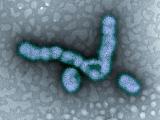Sep 30, 2011 (CIDRAP News) – A new analysis of influenza outbreak patterns in several navies in 1918 suggests that the first and second waves of the pandemic were caused by "antigenically distinct" viruses, a conclusion that runs counter to some other recent studies that have tried to discern why the second wave was so much more deadly than the first.
A team of Australian and American researchers, writing in The Lancet Infectious Diseases, says its analysis suggests that those who were infected in the mild first wave, in the spring or summer of 1918, remained susceptible to infection in the deadly second wave in the fall, but were protected from death.
If this is true, "the two waves of infection were probably caused by antigenically distinct influenza viruses—not by one virus that suddenly increased in pathogenicity between the first and second waves," says the report by G. Dennis Shanks, MD, of the Australian Army Malaria Institute, and colleagues.
This conclusion contrasts with a study published last week, in which US researchers examined preserved lung specimens from 68 US soldiers who died in the pandemic between May and October of 1918. They found that earlier and later cases featured the same type of lung damage, and they concluded that the pandemic virus was circulating by May.
The new findings also contrast with those of a 2008 study that covered similar ground. In that one, US researchers examined data mainly from US Army camps and found that soldiers who were infected in the first wave were both less likely to be infected and less likely to die in the fall onslaught of flu.
Sifting naval records
Researchers have been trying for years to explain the puzzling pattern of the 1918 pandemic, in the hope of drawing lessons for pandemic preparedness today. The Lancet report notes that the 1918-19 pandemic had three waves: one in the spring and summer of 1918 that was "highly infectious but clinically mild," one in the fall that was highly infectious and caused far higher mortality, and one in the winter of 1919 that was smaller and less deadly than the fall episode.
"The three waves of infection are often assumed to share the same viral cause; however, little objective evidence supports this notion," the report says.
The researchers studied illness records for the crews of ships in the British, Australian, US, and Japanese navies in 1918, and also looked at morbidity and mortality records for some island residents. They focused on ships' crews because of their homogeneous composition, isolation at sea, and consistent record keeping.
Nearly all ships had flu outbreaks, but few had deaths, the team found. However, the ships that did have deaths tended to have many, mostly during the second wave. Citing previous work, the authors say an estimated 1.1% of US Navy personnel died during the pandemic.
One ship that exemplified the general pattern was the USS Salem, which patrolled the Caribbean, according to the report. In February 1918 the ship had a flu outbreak that affected many of the crew but caused no serious complications. Then in September and October, during the second wave, 13% of the crew got sick, but all survived.
A contrasting example was the USS Pittsburgh, which patrolled the Atlantic off South America in 1918. When the ship docked in Rio de Janeiro in early October, 663 sailors—about 80% of the crew—contracted flu, and 59 of them died. Those deaths accounted for nearly half of all flu-pneumonia deaths on US Navy cruisers that year.
"In general, naval warships that had high mortality during the second wave were not affected by the first wave because of their relative isolation (eg, in the southern hemisphere)," the report says.
US military personnel in Hawaii offered another example, the researchers found. Many of the sailors and soldiers there had a mild flu-like illness in mid-1918. Later in the year, when the second pandemic wave hit, only one US sailor in Hawaii died of flu and pneumonia. A similar pattern was seen in a US Army camp in Puerto Rico.
The authors say two scenarios are commonly suggested to explain how the pandemic evolved. One is that a highly pathogenic but poorly transmissible H1N1 virus circulated undetected before 1918, causing only small outbreaks, but in mid 1918 it suddenly turned more transmissible and spread worldwide.
The second idea is that a clinically mild but highly transmissible H1N1 virus emerged in early 1918, and then suddenly became much more pathogenic. Both theories involve a sudden change in one or more viral genes.
The researchers offer a different scenario. They say previous research suggests that three lines of reassortant H1N1 viruses were circulating in 1918 and were the forerunners, respectively, of all seasonal H1N1, pandemic H1N1, and typical swine flu strains since that time. The first wave may have been caused by a seasonal H1N1 strain and the second wave by the pandemic strain, they suggest. In that case, "Acquired immunity to infection with the seasonal strain altered clinical expressions of, but not susceptibility to, infection with the pandemic strain."
Autopsy findings point another direction
In contrast, the autopsy study published last week by a US team suggested that the pandemic virus was circulating as early as May 1918. In studying lung specimens, the team found that the illness in US soldiers who died in the first wave, from May to August, looked the same clinically and pathologically as it did in soldiers who died during the second wave.
They also analyzed hemagglutinin from some specimens and found some evidence that the virus in the second wave showed an increasing preference for human as opposed to avian airway cell receptors, but the distribution of viral material in the airways was similar in all cases.
In commenting on the Lancet study, Jeffery Taubenberger, MD, PhD, senior author of the autopsy study, said in an e-mail, "The 1918 pandemic virus was clearly circulating as early as May, since we found autopsy evidence of fatal infections, and the clinical course and pathology of those cases was no different from the later fall outbreak." Taubenberger is chief of the Viral Pathogenesis and Evolution Section in the infectious diseases lab at the National Institute of Allergy and Infectious Diseases.
Taubenberger observed that illness outbreaks that occurred earlier in 1918, such as in March, have often been cited as part of the first pandemic wave. But he said there is "no convincing data that these outbreaks were or were not caused by the pandemic virus (or a pandemic precursor strain)." Because hardly anyone died in those outbreaks, no autopsy material is available to study, he noted.
"As Drs. Brundage and Shanks discuss in the [Lancet] paper, these outbreaks could also have been caused by a strain of seasonal influenza that circulated before the 1918 pandemic, or maybe were caused by other non-influenza respiratory pathogens (or some combination)," he said. "Unless case material is found, there will be no way to prove one way or the other what caused these outbreaks, as there are no viral isolates."
Historian disputes conclusion
Historian John M. Barry, who wrote The Great Influenza, a widely read chronicle of the 1918 pandemic, rejects the view that the two pandemic waves in 1918 were caused by different viruses. Barry was also the first author of a 2008 study of flu patterns in US Army camps in 1918, which suggested that those who were infected in the first wave had protection from both infection and death when the second wave came.
"I think all the evidence, both epidemiologic and now molecular, points to the opposite conclusion of this [Lancet] paper," Barry told CIRAP News. "I think the evidence strongly suggests the same virus caused the spring and fall 1918 waves. They say the spring wave protected against death but not against infection. That is not correct. We found up to 94% protection against illness—a somewhat higher level of protection against illness than against death."
Even if it were true that infection in the first wave conferred protection against death but not illness in the second wave, Barry said, "Protection against death is hardly evidence to support an argument that different viruses caused the different waves. That is a very tortured argument. And of course the recent PNAS [Taubenberger] paper found molecular evidence that the same virus caused both waves."
Barry also took the researchers to task for saying they are unaware of other cases in which circulating fu viruses showed sudden changes in pathogenicity. In the pandemic of 1889-92, he says, the third wave was the most lethal, adding, "Possibly those three waves were caused by different viruses, but we don't know that. You can't simply define it away and reject it as a precedent because it doesn't fit your premise."
Another case in which a circulating flu virus might have abruptly become more pathogenic was the flu season of 1951, when a seasonal H1N1 virus caused the deadliest influenza year of the 20th century, other than 1918 to 1920, Barry said.
Shanks GD, Waller M, MacKenzie A, et al. Determinants of mortality in naval units during the 1918-19 influenza pandemic. Lancet Infect Dis 2011 Oct;11(10):793-9 [Abstract]
See also:
Sep 20 CIDRAP News story "Autopsy study leaves severity of fall 1918 pandemic flu wave a mystery"
Oct 2, 2008, CIDRAP News story "First flu wave in 1918 was vaccine for some"
Taubenberger study abstract




















